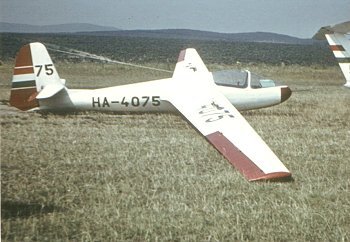| Type designation: | "lamináris" R-22S |
|---|---|
| Name: | "lamináris" Június-18 |
| Designer: | Márton PAPP, György MEZŐ, Imre TAKÁCS |
| Class: | High performance |
| General arrangement: | Cantilever mid-wing, closed cockpit with bubble canopy, fixed wheel, traditional tail unit |
| Crew: | 1 |
| First flight: | 1953 |
| Manufacturer: | Sportárutermelő V., Esztergom (former AeroEver Ltd.) |
| Number of built: | 1 |

.jpg)

| Dimensions: | |
|---|---|
| Wing: | |
| Span, m: | 16 |
| Area, m2: | 12.8 |
| Aspect ratio: | 20 |
| Chord (root), m: | 1.15 |
| Chord (tip), m: | 0.45 |
| Airfoil (root), m: | NACA 63(2)-615 |
| Airfoil (mid-span), m: | NACA 63(2)-615 |
| Airfoil (tip), m: | NACA 63(2)-615 |
| Dihedral, degree: | 2 |
| Sweep, degree: | -1.25 |
| Washout: | Geometric, -1.5 degrees |
| Aileron: | |
| Span, m: | 3.25 |
| Mean chord, m: | 0.22 |
| Total area, m2: | 1.43 |
| Balancing: | None |
| Airbrakes: | |
| Type: | Göppingen |
| Position (upside/downside): | u/d |
| Total area, m2: | 0.45 |
| Position, % of chord: | 0.48 |
| Horizontal stabilizer: | |
| Span, m: | 2.7 |
| Area, m2: | 1.97 |
| Elevator: | |
| Span, m: | 2.7 |
| Area, m2: | 1,11 |
| Airfoil: | NACA 0009 |
| Balancing: | None |
| Trim: | Tab |
| Vertical stabilizer and rudder: | |
| Total area, m2: | 1.56 |
| Rudder area, m2: | 0.896 |
| Balancing: | None |
| Fuselage: | |
| Length, m: | 6.5 |
| Width, m: | 0.62 |
| Height: | 0.97 |
| Cross section, m2: | 0.52 |
| Landing gear: | |
| Type: | Fixed |
| Wheel diameter, m: | 0.26 |
| Masses: | |
| Wing, kg: | 132 |
| Fuselage, kg: | 62 |
| Tail unit, kg: | 9 |
| Empty glider, kg: | 240 |
| Gross, kg: | 360 |
| Ballast, kg: | None |
| Wing loading, kg/m2: | 26.6 |
| Speeds: | |
| VNE, km/h: | 180 |
| Max. speed with open airbrakes, km/h: | 180 |
| Max. aerotow speed, km/h: | 120 |
| Max. winch speed, km/h: | 105 |
| Max. speed in rough air, km/h: | 160 |
| Stall speed, km/h: | 65 |
| Performance: | |
| Min. sink, m/s (at gliding speed, km/h): | ?/68 |
| Best L/D (at gliding speed, km/h): | 28/75 |
| Start methods: | Winch, Aerotow |
Origin of data and 3-view drawing:
Jereb Gábor: Magyar vitorlázó repülőgépek, Műszaki Könyvkiadó, 1988, Budapest
(Gábor JEREB: Hungarian Gliders, Technical Publishing House, 1988, Budapest)
Gábor FEKECS E-mail: fekecs.gabor@t-online.hu